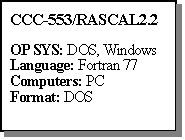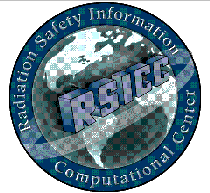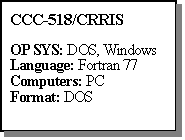The package is transmitted on CD-ROM as a compressed, self-extracting DOS file which includes Fortran source,
executables, data and test cases. References: ORNL/TM-8573 (August 1985), ORNL-5912 (October 1984), ORNL-5913
(November 1986), ORNL-5914 (October 1984), ORNL-5785 (November 1984), ORNL/CSD-99 (August 1984), ORNL-5974
(November 1984), and ORNL-5889 (November 1986). Fortran 77; PC (C00518/PC486/00).
 Oak Ridge National Laboratory, Oak Ridge, Tennessee, contributed a corrected version of this
code system for the radiological assessment for consequence analysis. The Source Term to Dose
model (ST-DOSE) was updated to correct calculation of the cloud shine dose. Modifications were
also made to the user interface so that the Ice Condenser source term options are available for the
Generic PWR, and some materials sites were added to the list of site names. No changes were
made to the DECAY calculator or Field Measurement to Dose model (FM-DOSE). RASCAL,
Version 2.2, estimates reactor source term, atmospheric transport and doses resulting from
radiological emergencies and can be used to assist in making protective action decisions. It includes a "close-in" straight-line
Gaussian plume model that computes doses at distances from 25 to 800 meters.
Oak Ridge National Laboratory, Oak Ridge, Tennessee, contributed a corrected version of this
code system for the radiological assessment for consequence analysis. The Source Term to Dose
model (ST-DOSE) was updated to correct calculation of the cloud shine dose. Modifications were
also made to the user interface so that the Ice Condenser source term options are available for the
Generic PWR, and some materials sites were added to the list of site names. No changes were
made to the DECAY calculator or Field Measurement to Dose model (FM-DOSE). RASCAL,
Version 2.2, estimates reactor source term, atmospheric transport and doses resulting from
radiological emergencies and can be used to assist in making protective action decisions. It includes a "close-in" straight-line
Gaussian plume model that computes doses at distances from 25 to 800 meters.
The recommended minimum configuration is a 386 PC and an EGA (or better) graphics adapter. MS-DOS 5.0 or higher is
recommended; it also runs under Windows95. Microsoft compilers were used to compile the Fortran (Version 5) and C
(Version 7) sources. Compiling the C source also requires Vermont Creative Software's Vermont Views libraries, used only
for data input. The package is transmitted on 3 DS/HD 3.5-in. (1.44 MB) diskettes which include source files, executables,
data, help files, and batch jobs in DOS files. References: NUREG/CR-5247 Vol. 1, Rev. 2, Supp. 1 (June 1997), and
NUREG/CR-5247 (ORNL-6820) Vol. 1, Rev. 2 (December 1994). Fortran 77, C; PC 386 (C00553/PC386/04).

CONFERENCES, COURSES, SYMPOSIA
RSICC attempts to keep its users/contributors advised of conferences, courses, and symposia in the field of radiation
protection, transport, and shielding through this section of the newsletter. Should you be involved in the
planning/organization of such events, feel free to send your announcements and calls for papers via email to raf@ornl.gov.
The First Latin American Symposium on Nuclear Tracks
The First Latin American Symposium on Nuclear Tracks will be held April 5-9, 1999, in Caracas, Venezuela. The symposium
will be devoted to review of the present knowledge of nuclear track science and technology and its applications in physics,
health, environmental studies, earth sciences and industry. Participants are encouraged to submit one-page abstracts, even if
they might be seen as preliminary results. The list of suggested topics are:
- Basic Physical Processes Related to Track Formation
- Track Observation and Measurement Methodology
- Environmental Radiation and Radon Studies
- Radiation Dosimetry
- Nuclear Physics
- Geoscience
- Medical Physics and Radiobiology
- Archeology
- Industry
- New Trends in Nuclear Tracks Science and Technology
Abstracts with the complementary registration page can be sent in three ways by the February 15, 1999 deadline:
1. By FAX to one the following numbers:
(+58-2) 906-3155 (Laboratorio de Física Nuclear, USB)
(+58-2) 906-3888 (Laboratorio de Física Nuclear, USB)
(+58-2) 605-2188 (Escuela de Física, Facultad de Ciencias, UCV)
2. By E-mail to one of the following addresses:
rmartin@fisica.ciens.ucv.ve
lsajo@usb.ve
asajo@usb.ve
fgutt@pion.ivic.ve
3. Send the abstract either by FAX or E-mail and then proceed with the electronic registration.
Details may be found on the internet at http://fisica.ciens.ucv.ve/~rmartin/1lasont/1lasont.html.
Radiation Protection in Medicine: Contemporary Issues
The National Council on Radiation Protection and Measurements (NCRP) has released the program for the 1999 Annual
Meeting. The meeting will be held April 7-8, 1999, in Arlington, Virginia. In keeping with its mission to formulate and
disseminate information, guidance and recommendations on radiation protection and measurements which represent the
consensus of leading scientific thinking, the theme of the meeting is Radiation Protection in Medicine: Contemporary Issues.
A summary of the program topics follows:
| General Issues |
| The Linear-Nonthreshold Dose--
Response Model: A Critical Reappraisal |
Arthur C. Upton
Rutgers University |
| Update of Medical Radiation Dosimetry |
Keith F. Eckerman
Oak Ridge Associated Universities |
| Developmental and Reproductive Risks--Radiological and
Nuclear Medicine Procedures During Pregnancy |
Robert L. Brent
Alfred I. duPont Hospital for Children |
| Diagnostic Radiology |
Andrew K. Poznanski
Session Chair |
| Radiation Protection Issues in Imaging Infants and Children |
Andrew K. Poznanski
Children's Memorial Hospital |
| Mammography |
Lawrence N. Rothenberg
Memorial Sloan-Kettering Cancer Center |
| New Developments in Computed Tomography |
Elliott K. Fishman
Johns Hopkins Hospital |
| Patient Dose and Quality Control
in Computed Radiography |
J. Anthony Seibert
University of California, Davis |
| Doses in Diagnostic Radiology--How and Why They Vary |
Orhan Suleiman
Food and Drug Administration |
| Nuclear Medicine |
Henry D. Royal
Session Chair |
| Therapy with Monoclonal Antibodies |
Richard L. Wahl
University of Michigan Medical Center |
| Outpatient Radionuclide Therapy |
Jeffry A. Siegel
Nuclear Physics Enterprises |
| Radiation Risk in the Thyroid |
Elaine Ron
National Cancer Institute |
| Radiation Oncology/Biology |
Sarah S. Donaldson
Session Chair |
| 3D Conformal Radiation Therapy |
Steven A. Leibel
Memorial Sloan-Kettering Cancer Center |
| Second Malignancies and Genetic Susceptibility |
Eric J. Hall
Columbia University |
| Accidents and Lessons Learned |
Fred A. Mettler, Jr.
University of New Mexico Medical School |
Twenty-Third Lauriston S. Taylor Lecture
Back to Background |
Naomi H. Harley
New York University Medical School |
| Interventional Procedures |
Jerrold T. Bushberg
Session Chair |
| Interventional Neurology |
Richard E. Latchaw
University of Miami Jackson Memorial Hospital |
| Vascular and Interventional Radiology--Spectrum of
Procedures and Radiation Risks |
Helen C. Redman
Southwestern Medical Center at Dallas |
| Interventional Cardiology |
Bruce D. Lindsay
Washington University School of Medicine |
| Perspectives on Risks of Radiation Skin Dose in
Fluoroscopy |
Louis K. Wagner
University of Texas, Houston Medical School |
| Management of Patient Dose During Fluoroscopy |
Benjamin R. Archer
Baylor College of Medicine |
| High-Dose Rate Brachytherapy in Coronary Artery
Restenosis |
Ron Waksman
Cardiology Research Foundation |
| Policy Issues |
Barbara McNeil
Session Chair |
| Training of Physicians and Support Staff |
Joel E. Gray |
| Irradiation of Human Subjects in Research |
Ruth R. Faden
Johns Hopkins University School of Hygiene and Public
Health |
No registration fee is required, but those wishing to attend should register in advance with the NCRP office (Suite 800, 7910
Woodmond Ave., Bethesda, MD 20814-3095, phone 301-657-2652) or at the meeting reception desk. Additional information
about the organization and meeting is available at the following web site: http://www.ncrp.com/.
Tenth International Symposium on Reactor Dosimetry
The Tenth International Symposium on Reactor Dosimetry will be held September 12-17, 1999, in Osaka, Japan. This
Symposium is held about every three years to provide a forum for the interchange of state-of-the-art techniques, databases and
standardization of radiation metrology. The Symposium will be of value to those involved in reactor dosimetry, including
researchers, manufacturers and representatives from industry, utilities and regulatory agencies. The Symposium is jointly
sponsored by the Atomic Energy Society of Japan (AESJ), the American Society for Testing and Materials (ASTM) and the
European Working Group on Reactor Dosimetry (EWGRD). It is organized by ASTM Committee E10 on Nuclear
Technology and Applications and EWGRD.
The Symposium theme is dosimetry for the assessment of irradiated reactor materials and reactor experiments, featuring
radiation metrology techniques, databases and standardization. Inquiries and requests to be added to the mailing list should be
sent to one of the following:
North & South America, East & Southeast Asia:
Dr. David W. Vehar
ASTM Program Secretary
Sandia National Laboratories, MS-1136
P.O. Box 5800, Albuquerque, NM 87185-1136, USA
Phone: 505-845-3414, fax: 505-844-0798
email: dwvehar@sandia.gov
Europe, Africa, Asia (other), and Australia:
Dr. Hamid Ait Abderrahim
EWGRD Programme Secretary
SCK/CEN
Boeretang 200, B-2400 Mol, BELGIUM
Phone: 32-14-332277, fax: 32-14-321529
email: haitabde@sckcen.be

"Half a Century of Radiation Shielding Research and Its Evolution into the Next Era" is the theme for the 9th International
Conference on Radiation Shielding to be held October 17-22, 1999, in Tsukuba, Japan. It is sponsored and organized by the
Japan Atomic Energy Research Institute and co-sponsored by the OECD-Nuclear Energy Agency-Nuclear Science Committee
(NEA-NSC), Atomic Energy Society of Japan (AESJ), and the Radiation Safety Information Computational Center (RSICC).
Participants in the conference explore the scientific, technological and engineering issues associated with radiation shielding
in broad nuclear energy systems, accelerator facilities, space and general environments. Detailed information about the
conference may be obtained from Yujiro Ikeda, Japan Atomic Energy Research Institute, Tokai Research Establishment,
Neutron Science Research Center, Spallation Neutronics Laboratory, Tokai-mura, Naka-gun, Ibaraki-ken 319-11 Japan
(phone 81-29-282-6074, fax 81-29-282-5709, email ikeda@fnshp.tokai. jaeri.go.jp) or from the web page at
http://icrs9.tokai.jaeri.go.jp.

Calendar
Your attention is directed to the following events of interest.
November 1998
International Symposium on Evolutionary Water-Cooled Reactors, Nov. 30-Dec. 4, 1998, Seoul, Republic of Korea,
sponsored by the IAEA. Contact: IAEA, Wagramerstrasse 5, P.O. Box 100, A-1400 Vienna, Austria (phone 43-1-20600, fax
x43-1-20607, email official.mail@iaea.org).
December 1998
Nuclear Decom '98, Dec. 2-3, 1998, London, sponsored by the Inst. of Mechanical Engineers. Contact: Alison Hamlett
(phone 44-0171-304-6864, fax 44-0171-222-9881, email a_hamlett@imeche.org.uk).
1998 Meeting of the National Organization of Test, Research, and Training Reactors, Dec. 13-16, 1998, Cambridge,
Massachusetts. Contact: John Bernard, Massachusetts Inst. of Technology Nuclear Research Lab (phone 617-253-4202, fax
217-253-7300, email jbernard@mit.edu).
March 1999
1999 Hardened Electronics and Radiation Technology (HEART), March 8-12, 1999, Monterey, California. Contact: Ralph
Nadell, Palisades Institute, Suite 1006, 201 Varick St., New York, NY 10014 (phone 212-620-3341, fax 212-620-3379).
April 1999
First Latin American Symposium on Nuclear Tracks and Radiation, April 5-9, 1999, Caracas, Venezuela, Institute for
Advanced Studies, Convention Centre. Contact: Professor Laszlo Sajo, Universidad Simon Bolivar, FE-1, Apdo 89000,
Caracas, Venezuela, (phone 58-2-906- 3590, fax 58-2-906-3712, email lsajo@fis.usb.ve).
35th Annual Meeting of the National Council on Radiation Protection and Measurements, Apr. 7-8, 1999, Arlington, Virginia.
Contact: NCRP, Suite 800, 7910 Woodmont Ave., Bethesda, MD 20814-3095 (phone 301-657-2652, fax 301-907-8768,
email ncrp@ncrp.com).
June 1999
Conference on Radionuclide Metrology and its Application, June 7-11, 1999, Prague. Contact: Pavel Dryák, Czech
Metrological Institute, Radiova 1, CZ 102 00 Prague, Czech Republic (phone 420-2-67008244, fax 420-2-67008466, email
pdryak@cmi.cz).
September 1999
Tenth International Symposium on Reactor Dosimetry, Sept. 12-17, 1999, in Osaka, Japan. Contact: Dr. David W. Vehar
(505-845-3414, fax 505-844-0798, email: dwvehar@sandia.gov) or Dr. Hamid Ait Abderrahim (32-14-332277, fax 32-
14-321529, email haitabde@sckcen.be).
October 1999
Half a Century of Radiation Shielding Research and Its Evolution into the Next Era (ICRS-9), Oct. 17-22, 1999, Tsukuba,
Japan, sponsored and organized by the Japan Atomic Energy Research Institute. Contact: Yujiro Ikeda, Japan Atomic Energy
Research Institute, Tokai Research Establishment, Neutron Science Research Center, Spallation Neutronics Laboratory,
Tokai-mura, Naka-gun, Ibaraki-ken 319-11 Japan (phone 81-29-282-6074, fax 81-29-282-5709, email
ikeda@fnshp.tokai.jaeri.go.jp, url http://icrs9.tokai.jaeri.go.jp).

SEPTEMBER ACCESSION OF LITERATURE
The following literature cited has been reviewed and placed in the RSICC Information Storage and Retrieval Information
System (SARIS), now searchable on the RSICC web server (http://www-rsicc.ornl.gov/SARIS.html). This early
announcement is made as a service to the shielding community. Copies of the literature are not distributed by RSICC.
They may generally be obtained from the author or from a documentation center such as the National Technical Information
Service (NTIS), Department of Commerce, Springfield, Virginia 22161. For literature listed as available from INIS contact
INIS Clearinghouse, International Atomic Energy Agency, P.O. Box 100, A-1400 Vienna.
RADIATION SHIELDING LITERATURE
Health Phys., 75, 259-268 . . . Evaluation of the Japanese Health Risks Induced by Global Fallout Tritium. . . . Nishimura,
R.; Morisawa, S.; Shimada, Y. . . . September 1998 . . . Mitsubishi, Research Institute, Inc., Tokyo, Japan; Graduate School of
Engineering, Kyoto University, Kyoto City, Japan.
Health Phys., 75, 269-277 . . . Three-Parameter Model for Estimating Atmospheric Tritium Dose at the Savannah River Site.
. . . Hamby D.M.; Simpkins, A.A. . . . September 1998 . . . University of Michigan, Ann Arbor, MI; Westinghouse Savannah
River Company, Aiken, SC.
Health Phys., 75, 278-284 . . . Residual 60Co Activity in Steel Samples Exposed to the Hiroshima Atomic-Bomb Neutrons. . .
. Shizuma, K.; Iwatani, K.; Hasai, H.; Oka, T.; Endo, S.; Takada, J.; Hoshi, M.; Fujita, S.; Wataname, T; Imanaka, T. . . .
September 1998 . . . Hiroshima University, Higashi-Hiroshima, Japan; Hiroshima-Denki Institute of Technology, Hiroshima,
Japan; Kure University, Kure, Japan; Radiation Effects Research Foundation, Hiroshima, Japan; Research Reactor Inst.,
Osaka, Japan.
Health Phys., 75, 285-290 . . . Multisphere Neutron Spectra Measurements Near A High Energy Medical Accelerator. . . .
Veinot, K.G.; Hertel, N.E.; Brooks, K.W.; Sweezy, J.E. . . . September 1998 . . . Georgia Institute of Technology, Atlanta,
GA; Emory University of Medicine, Atlanta, GA; NPTU-Bettis, Goose Creek, SC.
Medical Phys., 25, 1702-1710 . . . Forward and Adjoint Methods for Radiotherapy Planning. . . . Difilippo, F.C. . . .
September 1998 . . . Oak Ridge National Laboratory, Oak Ridge, TN.
INDC(NDS)-383 . . . Co-ordination of the Nuclear Reaction Data Centers, Report on an IAEA Advisory Group Meeting,
IAEA Headquarters, Vienna (11-15 May 1998). . . . Pronyaev, V.G.; Schwerer, O. eds. . . . July 1998 . . . IAEA Nuclear Data
Section, Vienna, Austria.
ORNL/TM-13315 . . . Validation of Scale (SAS2H) Isotopic Predictions for BWR Spent Fuel. . . . Hermann, O.W.; DeHart,
M.D. . . . September 1998 . . . Oak Ridge National Laboratory, Oak Ridge, TN.
ORNL/TM-13624 . . . ORIGEN-S Decay Data Library and Half-Life Uncertainties. . . . Hermann, O.W.; Daniel, P.R.;
Ryman, J.C. . . . September 1998 . . . Oak Ridge National Laboratory, Oak Ridge, TN.


